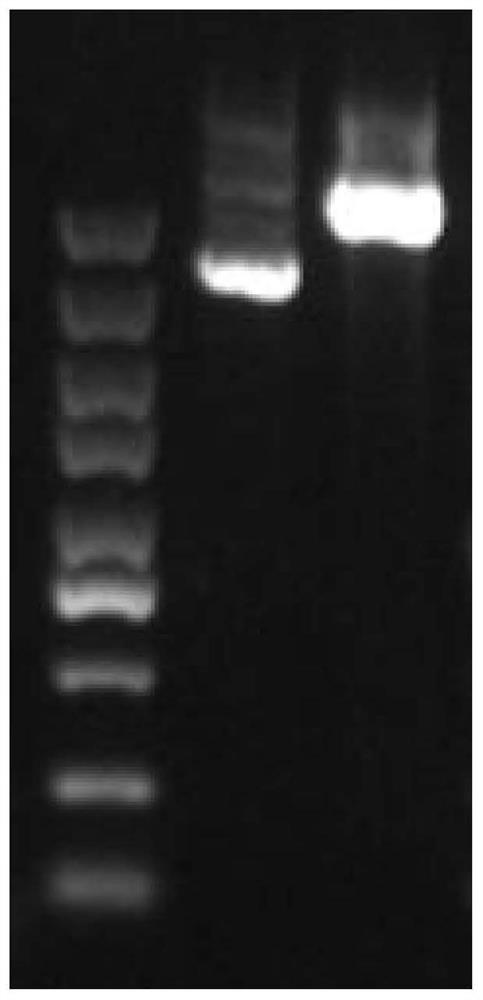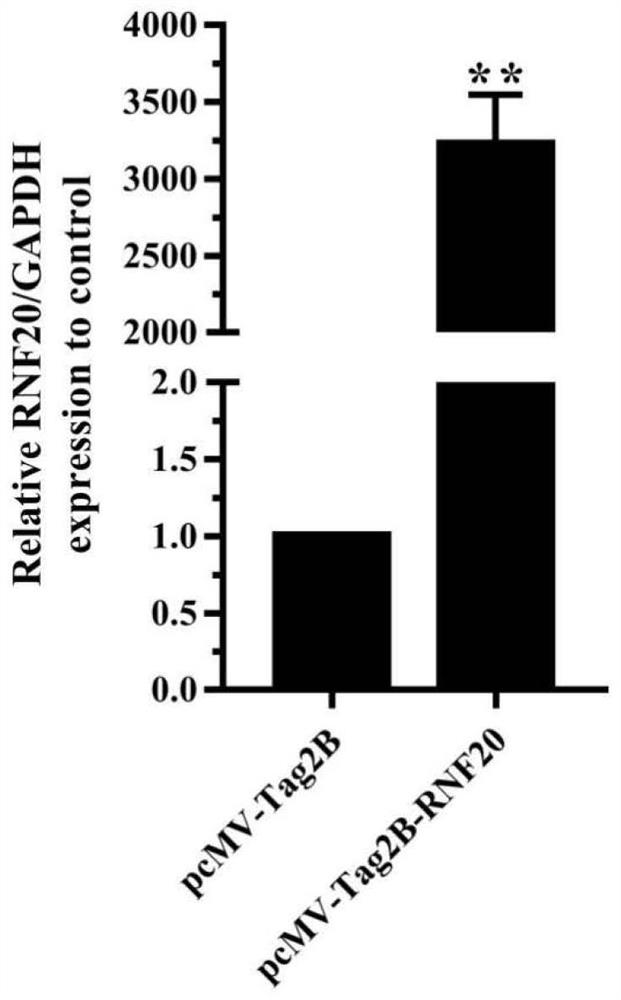Construction of human RNF20 gene overexpression plasmid vector and effect of human RNF20 gene overexpression plasmid vector on inhibiting cancer cells
A technology of gene overexpression and plasmid vectors, applied in vectors, nucleic acid vectors, DNA/RNA fragments, etc., to achieve the effects of promoting apoptosis, promoting transcription and translation, and inhibiting proliferation and migration
- Summary
- Abstract
- Description
- Claims
- Application Information
AI Technical Summary
Problems solved by technology
Method used
Image
Examples
Embodiment 1
[0025] Embodiment 1: Preparation of human RNF20 gene overexpression plasmid vector
[0026] 1. Preparation of human RNF20 gene
[0027] Select the coding region sequence of human RNF20 (NM_019592.7) gene from Genbank of NCBI website, use Primer5 software, according to the pcMV-Tag2B plasmid vector map, combined with the existing restriction endonucleases in our laboratory, select BamHI and HindIII two Restriction site, design the upstream primer and downstream primer of human RNF20 gene. Using the cDNA of human mesenchymal stem cell HMSC as a template, the sequence was amplified by PCR technology to obtain the target gene, namely human RNF20 gene. Wherein, the upstream primer sequence of the human RNF20 gene designed by Primer5 software is SEQ ID NO.1, and the downstream primer sequence is SEQ ID NO.2. The reaction system for sequence amplification using PCR technology is shown in Table 1. PCR technology is used to amplify the sequence. The reaction conditions of the increas...
Embodiment 2
[0041] Example 2: Using real-time fluorescent quantitative RT-PCR to detect the high expression efficiency of human RNF20 gene after transfection of pcMV-Tag2B-RNF20 plasmid vector
[0042]Human HT29 cells in logarithmic growth phase were digested with trypsin, prepared into cell suspension with D-MEM / F-12 medium containing 10% AusGeneX serum, and 1.2×10 6 cells were seeded in a 6-well plate, which was then placed at 37 °C, 5% CO 2 cultured in an incubator to allow the cells to adhere to the wall. Transfection can be started when the cell density grows to 70-80%, and the transfection mixture is prepared according to the transfection system according to the plasmid concentration and the instructions of the transfection reagent TurboFect. Among them, the 6-well plate transfection system is shown in Table 5.
[0043] Table 5: 6-well plate transfection system
[0044]
[0045] Place the previous transfection mixture at 37 °C, 5% CO 2 Incubate in an incubator for 20 minutes,...
Embodiment 3
[0052] Example 3: Detection of proliferation ability of cancer cells transfected with pcMV-Tag2B-RNF20 plasmid
[0053] Human HCT116 and HT29 cells in the logarithmic growth phase were digested with trypsin, and prepared into cells with D-MEM / F-12 medium containing 10% AusGeneX serum and DMEM high-glucose medium containing 10% AusGeneX serum, respectively Suspension, 4~5×10 per well 4 cells were seeded in a 96-well plate, and then placed at 37 °C, 5% CO 2 cultured in an incubator to allow the cells to adhere to the wall. Transfection can be started when the cell density grows to 70-80%, and the transfection mixture is prepared according to the transfection system according to the plasmid concentration and the instructions of the transfection reagent TurboFect. Among them, the 96-well plate transfection system is shown in Table 8.
[0054] Table 8: 96-well plate transfection system
[0055]
[0056] Place the previous transfection mixture at 37 °C, 5% CO 2 Incubate in t...
PUM
| Property | Measurement | Unit |
|---|---|---|
| molecular weight | aaaaa | aaaaa |
Abstract
Description
Claims
Application Information
 Login to View More
Login to View More - R&D
- Intellectual Property
- Life Sciences
- Materials
- Tech Scout
- Unparalleled Data Quality
- Higher Quality Content
- 60% Fewer Hallucinations
Browse by: Latest US Patents, China's latest patents, Technical Efficacy Thesaurus, Application Domain, Technology Topic, Popular Technical Reports.
© 2025 PatSnap. All rights reserved.Legal|Privacy policy|Modern Slavery Act Transparency Statement|Sitemap|About US| Contact US: help@patsnap.com



